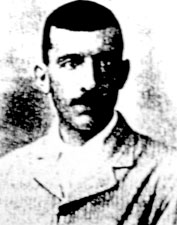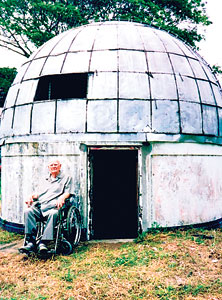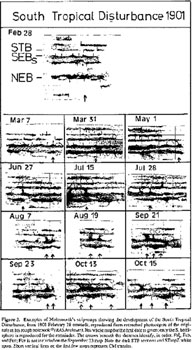Christmas Day 2008 marks the 100th death anniversary of a remarkable man who pioneered astronomical observations in colonial Ceylon. Most people living today in the land of his birth might not have heard of him, but a large crater on Mars immortalises his name.
 |
| Percy Braybrooke Molesworth |
By profession, Percy Braybrooke Molesworth (1867 - 1908) was a major in the corps of Royal Engineers but he was better known as one of the world's leading amateur astronomers at the beginning of the Twentieth Century. From his personal observatory in Trincomalee, Molesworth both observed the night sky and photographed celestial bodies, the results of which he shared with leading astronomical groups in the west. Armed only with a basic telescope, a sharp eye and good drawing skills, he made significant contributions to a greater understanding of the heavens. While he blazed new frontiers in a short life time, the events since his premature death show how callously our nation treats scientific accomplishments.
Percy Molesworth was born in British ruled Ceylon on April 2, 1867. He was the youngest son of Sir Guildford Lindsey Molesworth (1828 – 1925), the first general manager of Ceylon Railways, who is best remembered for having driven the country's first train engine on its maiden journey from Colombo to Ambepussa on December 27, 1864.
Percy was educated at Winchester College in England and obtained his commission in the Corps of Royal Engineers in 1886. After passing through the Royal Military Academy at Woolwich and Chatham, he was sent to Hong Kong for three years, during which time he started dispatching his early drawings of Mars to the British Astronomical Association (BAA) of which he was a founding member.
Return to Ceylon
Upon return to England, Molesworth sought a placement in Ceylon. He was posted to the island of his birth in 1896, assigned to be 'engaged in perfecting the defences of Trincomalee'. Although his work and hobby still took him to various places in Asia and Africa, Trincomalee soon became home, from where he would scan the equatorial skies for the next decade.
 |
| Sir Arthur Clarke visiting Colombo University’s telescope dome in 2004 and (below), sitting next to the historic telescope showing a photo of Crater Molesworth |
Contemporaries have described Molesworth as having 'keen eyesight, great artistic skill, and above all, enormous energy'. Sir Arthur C. Clarke, another astronomically-inclined Englishman who was to settle down in Ceylon decades later, once wrote: "As an invasion from India did not seem a serious threat, Molesworth had plenty of spare time -- and used it very effectively to make some superb maps of Mars, using a 12.5-inch (32cm) Calver reflector."
Molesworth set up his personal observatory on the front lawn of his bungalow, from where he could view the sea in one direction and Fort Frederick in the other. His property was several hundred feet above sea level, which gave him a superb sea horizon for his observations. Moreover, being located just 8.5 degrees north of the Equator he had a considerable advantage over astronomers in the higher latitudes in Europe and North America -- he could see far more of the southern skies from Trincomalee. And in those pre-electricity days, light pollution was unheard of, allowing easy access to the night sky.
Molesworth exploited all these advantages for astronomical observations, and soon built up a reputation as one of the finest of his kind in the East. A diligent observer and chronicler, he was admitted to membership of the prestigious Royal Astronomical Society (RAS) in 1898 -- the same year he joined a solar eclipse expedition to India.
Molesworth observed various celestial objects, but it was the planets -- especially Mars and Jupiter -- that most engaged his interest. In February 1901, he became the first observer in the world to notice the beginning of the great South Tropical Zone Disturbance on Jupiter that was to last until 1939. This discovery was very important in understanding Jovian atmospheric currents. Its conjunctions with the Great Red Spot gave clues to the magnitude and directions of wind speeds on the largest planet in the solar system well before unmanned spacecraft flew past in the 1970s and 1980s.
Over-worked
Molesworth did not merely observe and draw; he also analysed what he saw. This often required crunching large numbers which, in those pre-calculator days, had to be done entirely manually. One such set of calculations took him seven months of spare time, at the end of which he noted: "Had I known the amount of labour they would entail, I should, I think, have hesitated before embarking on such a task."
Driving himself hard was characteristic of the man, but it soon took its toll. In 1904, a sharp attack of pleurisy and fever forced him to return to England for five months. E. M. Antoniadi, a leading Mars observer of the time, later wrote: "Overwork of this kind, in such a torrid climate as that of Ceylon, finally injured his health."
Molesworth took early retirement in 1906, and bought an estate in Trincomalee to devote his time and energies to astronomical work. But it was not to be. According to the RAS obituary, "on his return from a short visit to England, he succumbed to a severe attack of dysentery, and passed away on Christmas Day 1908." He was only 41 at the time.
His friend Walter Maunder managed to transfer his papers and notes to the care of the RAS, where generations of astronomers have been studying them in awe and writing many scholarly papers. In 1973, the International Astronomical Union (IAU) named one of the largest craters on Mars in his honour. Crater Molesworth, located on the Red Planet's southern hemisphere, is 175 kilometres across.
In the land of his birth, meanwhile, Molesworth is now remembered only by a few latter- day star-gazers. One of them, the late Herschel Gunawardena, went in search of Molesworth in 1971 and found the house being used as a tourist centre in Trincomalee. He later wrote in Equatorial, journal of the Ceylon Astronomical Association: "Only a little of the observatory now remains, a part of the original foundation with a central rock slab which Molesworth may have used to attach his heavy pier can still be seen."
Forgotten legacy
Herschel tracked down Molesworth's tombstone in the Trincomalee cemetery with great difficulty, but found no other memorial. Writing in the RAS Journal in 1977, Sir Arthur Clarke also lamented how there was no trace of Molesworth anywhere in Trincomalee.Three decades later, Sir Arthur was to include several references to Molesworth in what turned out to be his last science fiction novel, The Last Theorem, published posthumously in August 2008. When the novel's protagonist Ranjit Subramanian is growing up in Trincomalee during the closing years of the Twentieth Century, his father tells him stories about Molesworth. This inspires the young man to study mathematics and astronomy, leading to some dramatic results for himself and humanity…
In the real world, however, the plight of the Molesworth observatory illustrates a clear lack of interest in preserving our cultural and intellectual heritage, especially those from the colonial periods.
 |
| Extract from Molesworth’s detailed maps of Jupiter in 1901 when he made the major discovery of the South Tropical Zone Disturbance |
Nobody is certain exactly what happened to the observatory following Molesworth's death. According to some reports, the custom-made Calver telescope went into disuse; others say it was stolen. It somehow turned up in Colombo years later, where it was restored and used for a while at the Colombo Observatory attached to the Department of Meteorology. It was then gifted to the University College, later University of Colombo, which housed it in a small dome building on the University ground adjoining Reid Avenue.
During the second World War, the Royal Air Force took over the dome for an anti-aircraft gun defending the city against Japanese air raids. When the War ended, the telescope was left with a broken diagonal and roughly handled mirror. It took many years for the instrument to be repaired and involved efforts by several academics including professors C.J. Eliezer and A.W. Mailvaganam.
Once restored, the Molesworth telescope went through periods of use and disuse. In early 1988, while the country (by then Sri Lanka) was engulfed in the brutal second southern insurgency, vandals looted the dome and removed several parts purely for their metallic value.
Death of an Observatory
The telescope never fully recovered from that looting, and the University administration showed little enthusiasm in preserving it. Occasionally, an amateur astronomer or university academic would take some personal interest, but the institutional indifference remains.
Sometime during 2004, while researching material for The Last Theorem, Sir Arthur Clarke visited Colombo University to take another look at the Molesworth telescope. Ever the optimist, he noted soon afterwards: "The local amateur astronomers are working to repair it -- and although Colombo is hardly a good observing site, I hope they can use it effectively. At least they can see more than 90 per cent of the world’s sky – everything except a small patch over the South Pole."
Sadly, as a century passes since Molesworth's death, he remains a forgotten man in his native town and land of birth. But millions of miles away from home, Crater Molesworth beckons future Mars explorers.
Trained as a science writer, Nalaka Gunawardene worked with Sir Arthur C. Clarke as a research assistant for over 20 years. He now blogs on media, society and development at: http://movhngimages.wordpress.com/ |
